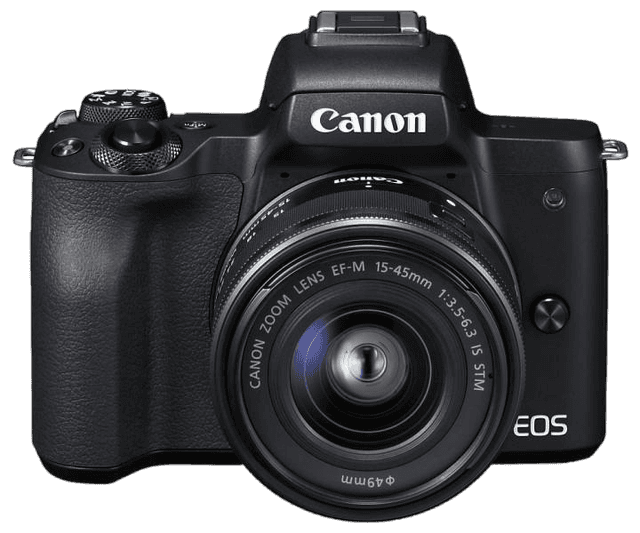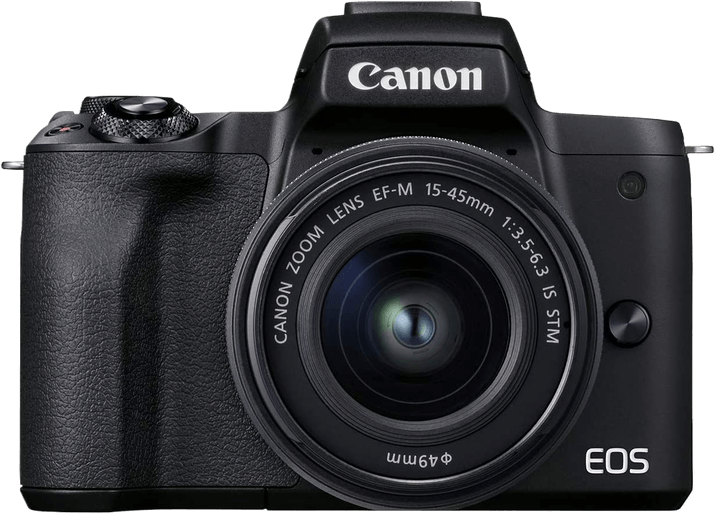Canon EOS M50 vs EOS M50 Mark II Comparison
Canon EOS M50

Canon EOS M50 Mark II

The Canon EOS M50 and Canon EOS M50 Mark II are both mirrorless cameras with a score of 59/100. They share the same camera size (116 x 88 x 59mm) and have a slight difference in weight, with the M50 weighing 390g and the M50 Mark II at 387g.
The M50 Mark II, released in 2020, is an improved version of the M50, which was released in 2018. The Mark II is slightly more affordable, with a launch price of $750 compared to the M50’s $779. This newer model is also marginally lighter, making it more convenient for travel and extended use.
While both cameras share the same score, the M50 Mark II offers better value for money due to its lower price and lighter weight. The M50, on the other hand, does not have any clear advantages over its successor. Therefore, the Canon EOS M50 Mark II is the better choice between these two cameras.
Canon EOS M50 vs EOS M50 Mark II Overview and Optics
The Canon EOS M50 and the Canon EOS M50 Mark II both score 59/100 for their optics, indicating no difference in overall quality. Both cameras share several specifications, including a 24-megapixel resolution, 10 fps shooting speed, CMOS sensor type, Digic 8 processor, DXOMARK score of 58 for the sensor, APS-C sensor size, Canon EF-M lens mount, and no image stabilization.
Despite having the same score, the EOS M50 Mark II is slightly better in terms of autofocus performance. It has an improved Dual Pixel CMOS AF system, which provides faster and more accurate focusing in various shooting situations. This can be beneficial for capturing fast-moving subjects or ensuring sharp images in low-light conditions.
On the other hand, the EOS M50 has a slightly larger viewfinder, which can be advantageous when composing shots or reviewing images. However, this difference is minimal and is unlikely to significantly impact the overall shooting experience.
Both cameras are quite similar in terms of optics, with the EOS M50 Mark II offering a slight edge in autofocus performance, while the EOS M50 has a marginally larger viewfinder. Neither camera has a clear advantage in terms of image quality, as both share the same sensor, processor, and lens mount. Ultimately, the choice between the two models will depend on the individual’s specific needs and preferences.
Canon EOS M50 vs EOS M50 Mark II Video Performance
When comparing the video capabilities of the Canon EOS M50 and the Canon EOS M50 Mark II, both cameras tie with a video score of 91 out of 100. This shows that they offer similar performance in terms of video recording.
Both cameras share common video specifications. They have the same maximum video resolution of 4K and maximum video dimensions of 3840 x 2160. Additionally, they both offer a maximum video frame rate of 120fps and have built-in time-lapse functionality. These shared features make both cameras suitable for a variety of video projects and time-lapse photography.
The Canon EOS M50, despite having the same video score as the M50 Mark II, does not offer any significant advantages over its counterpart in terms of video capabilities. Both cameras provide users with the same level of video performance, making it difficult to determine a clear winner in this category.
Similarly, the Canon EOS M50 Mark II does not surpass the EOS M50 in terms of video capabilities. With the same video score and specifications, it is also on par with the EOS M50. The choice between these two cameras should be based on factors other than video performance, as they are essentially equal in this aspect.
Given the identical video scores and specifications, it can be concluded that the Canon EOS M50 and the Canon EOS M50 Mark II offer the same video capabilities. Users should consider other factors, such as price, design, and additional features, when deciding which camera to purchase. Both cameras will provide satisfactory video performance for various projects and time-lapse photography.
Canon EOS M50 vs EOS M50 Mark II Features and Benefits
The Canon EOS M50 and the Canon EOS M50 Mark II both have a feature score of 70/100. This means that there is no clear winner in terms of features, as both cameras offer the same level of functionality.
Both cameras share common specifications, including a 3-inch screen size, a screen resolution of 1040000 dots, a touchscreen, a flip screen, and the absence of GPS. Additionally, both cameras are equipped with WIFI and Bluetooth capabilities.
Since both cameras have the same feature score and share the same specifications, it is challenging to determine which camera is better based on their features alone. However, it is essential to consider other factors such as performance, image quality, and handling, among others, to determine which camera is more suitable for a user’s needs.
While the Canon EOS M50 and the Canon EOS M50 Mark II share the same feature score, it is important to remember that the score does not solely determine the quality of the camera. The score simply reflects the similarities between the two models in terms of features. A higher score does not make a camera better, but rather indicates that the camera has more features or better specifications.
Taking all of these aspects into consideration, it is evident that both the Canon EOS M50 and the Canon EOS M50 Mark II are similar in terms of features. Users should focus on other factors such as performance, image quality, and handling to determine which camera is more suitable for their specific needs and preferences.
Canon EOS M50 vs EOS M50 Mark II Storage and Battery
The Canon EOS M50 Mark II outperforms the Canon EOS M50 in storage and battery, scoring 21 out of 100 compared to the EOS M50’s 13 points. Both cameras share similarities in storage, with each having one memory card slot and accepting SD, SDHC, and SDXC (UHS-I compatible) cards. They also have the same battery type, the LP-E12, but lack USB charging.
The EOS M50 Mark II excels with a longer battery life, providing 305 shots per charge compared to the 235 shots offered by the EOS M50. This advantage allows for extended shooting sessions without needing to change the battery as frequently.
On the other hand, the EOS M50 does not offer any significant benefits over the Mark II in terms of storage and battery. The lower battery life is its main drawback compared to its successor.
Considering the longer battery life of the EOS M50 Mark II, it is the better choice for users who prioritize extended shooting times. The EOS M50 falls short in this aspect, making the Mark II the superior option when comparing storage and battery capabilities.
Canon EOS M50 vs EOS M50 Mark II Alternatives
If you haven’t decided on a camera just yet, have a look at these camera comparisons too:
